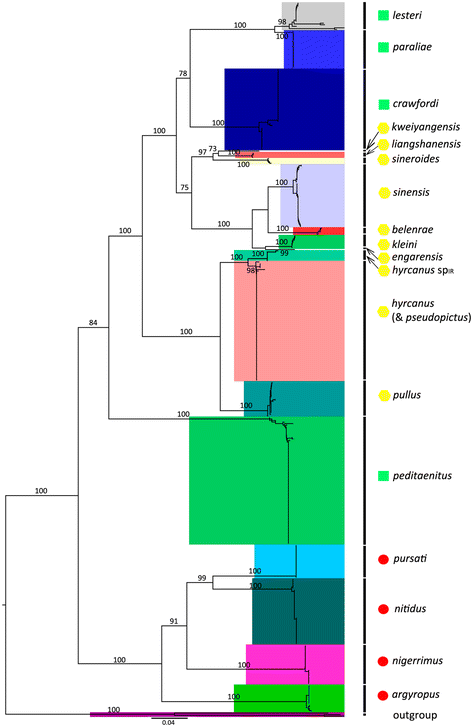Molecular phylogeny of Anopheles hyrcanus group members based on ITS2 rDNA
- PMID: 28882174
- PMCID: PMC5590201
- DOI: 10.1186/s13071-017-2351-x
Molecular phylogeny of Anopheles hyrcanus group members based on ITS2 rDNA
Abstract
Background: The Anopheles hyrcanus group includes 25 species, and is widely distributed in the Oriental and Palaearctic regions. Several species within this group are vectors of malaria, lymphatic filariasis and Japanese encephalitis. It is difficult or impossible to identify cryptic species based on their morphological characteristics, with some closely related species of the Hyrcanus Group have similar adult morphological characteristics. Thus, their molecular identification has been an important complementary method to traditional morphological taxonomy.
Methods: We used 461 ribosomal DNA (rDNA) internal transcribed spacer 2 (ITS2) sequences relating to 19 species to reconstruct the molecular phylogeny of the Hyrcanus Group across its range. In addition, we compared the performance of rDNA ITS2 to that of mitochondrial DNA (mtDNA) cytochrome c oxidase subunit 1 gene (cox1) to assess the genetic divergence of Hyrcanus Group sibling species.
Results: Based on Kimura's 2-parameter (K2P) distance model, the average conspecific ITS2 divergence was 0.003, whereas sequence divergence between species averaged 0.480. Average ITS2 sequence divergences were almost 160 times higher among the Hyrcanus Group members than within each species. Two sets of sibling species, An. lesteri Baisas & Hu, 1936 and An. paraliae Sandosham, 1959; and An. sinensis Wiedemann, 1828, An. belenrae Rueda, 2005, and An. kleini Rueda, 2005, were resolved by ITS2. Each of these species was represented as an independent lineage in the phylogenetic tree. Results suggest that An. pseudopictus Grassi, 1899 and An. hyrcanus (Pallas, 1771) are most likely a single species. We uncovered two new ITS2 lineages that require further study before resolving their true taxonomic status, and designed a diagnostic polymerase chain reaction (PCR) assay to distinguish five morphologically similar species.
Conclusions: Nuclear and mitochondrial genes generally provided consistent results for subgroup division. Compared to cox1, ITS2 is a more reliable tool for studying phylogenetic relationships among closely related mosquito taxa. Based on species-specific differences in ITS2 sequences, the multiplex PCR assay developed here can be used to improve the efficiency of vector identification. Thus, this research will promote the progress of malaria vector surveillance in both epidemic and non-epidemic areas of South and East Asia.
Keywords: Anopheles; DNA barcoding; Malaria.
Conflict of interest statement
Ethics approval and consent to participate
No specific permits were required for this study. The study did not involve endangered or protected species. Therefore, the local ethics committee deemed that approval was unnecessary.
Consent for publication
Not applicable.
Competing interests
The authors declare that they have no competing interests.
Publisher’s Note
Springer Nature remains neutral with regard to jurisdictional claims in published maps and institutional affiliations.
Figures




Similar articles
-
Molecular phylogeny of the Anopheles hyrcanus group (Diptera: Culicidae) based on rDNA-ITS2 and mtDNA-COII.Parasit Vectors. 2021 Sep 6;14(1):454. doi: 10.1186/s13071-021-04971-4. Parasit Vectors. 2021. PMID: 34488860 Free PMC article.
-
Molecular phylogeny of Anopheles hyrcanus group (Diptera: Culicidae) based on mtDNA COI.Infect Dis Poverty. 2017 May 8;6(1):61. doi: 10.1186/s40249-017-0273-7. Infect Dis Poverty. 2017. PMID: 28478763 Free PMC article.
-
Phylogeny of certain members of Hyrcanus group (Diptera: Culicidae) in China based on mitochondrial genome fragments.Infect Dis Poverty. 2019 Oct 23;8(1):91. doi: 10.1186/s40249-019-0601-1. Infect Dis Poverty. 2019. PMID: 31647031 Free PMC article.
-
The second internal transcribed spacer of nuclear ribosomal DNA as a tool for Latin American anopheline taxonomy - a critical review.Mem Inst Oswaldo Cruz. 2006 Dec;101(8):817-32. doi: 10.1590/s0074-02762006000800002. Mem Inst Oswaldo Cruz. 2006. PMID: 17293975 Review.
-
DNA barcoding mosquitoes: advice for potential prospectors.Parasitology. 2018 Apr;145(5):622-633. doi: 10.1017/S0031182018000343. Epub 2018 Mar 22. Parasitology. 2018. PMID: 29564995 Review.
Cited by
-
Airport Malaria in Non-Endemic Areas: New Insights into Mosquito Vectors, Case Management and Major Challenges.Microorganisms. 2021 Oct 16;9(10):2160. doi: 10.3390/microorganisms9102160. Microorganisms. 2021. PMID: 34683481 Free PMC article. Review.
-
Population genetic structure and evolutionary genetics of Anopheles sinensis based on knockdown resistance (kdr) mutations and mtDNA-COII gene in China-Laos, Thailand-Laos, and Cambodia-Laos borders.Parasit Vectors. 2022 Jun 26;15(1):229. doi: 10.1186/s13071-022-05366-9. Parasit Vectors. 2022. PMID: 35754022 Free PMC article.
-
Evaluation of intron-1 of odorant-binding protein-1 of Anopheles stephensi as a marker for the identification of biological forms or putative sibling species.PLoS One. 2022 Jul 21;17(7):e0270760. doi: 10.1371/journal.pone.0270760. eCollection 2022. PLoS One. 2022. PMID: 35862377 Free PMC article.
-
DNA barcodes corroborating identification of mosquito species and multiplex real-time PCR differentiating Culex pipiens complex and Culex torrentium in Iran.PLoS One. 2018 Nov 14;13(11):e0207308. doi: 10.1371/journal.pone.0207308. eCollection 2018. PLoS One. 2018. PMID: 30427929 Free PMC article.
-
New strains of Japanese encephalitis virus circulating in Shanghai, China after a ten-year hiatus in local mosquito surveillance.Parasit Vectors. 2019 Jan 9;12(1):22. doi: 10.1186/s13071-018-3267-9. Parasit Vectors. 2019. PMID: 30626442 Free PMC article.
References
-
- Harbach RE. The phylogeny and classification of Anopheles. In: Manguin S, editor. Anopheles mosquitoes - new insights into malaria vectors. Croatia: InTech; 2013. p. 3–55.
-
- Fang Y, Shi W, Zhang Y. [Research progress in classification of Anopheles hyrcanus group (Diptera: Culicidae)]. Chin J Parasitol Paras Dis. 2016;34:565–70. (In Chinese). - PubMed
-
- Poncon N, Toty C, Kengne P, Alten B, Fontenille D. Molecular evidence for similarity between Anopheles hyrcanus (Diptera: Culicidae) and Anopheles pseudopictus (Diptera: Culicidae), sympatric potential vectors of malaria in France. J Med Entomol. 2008;45:576–580. doi: 10.1093/jmedent/45.3.576. - DOI - PubMed
MeSH terms
Substances
LinkOut - more resources
Full Text Sources
Other Literature Sources

